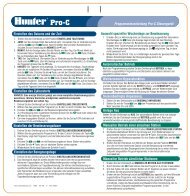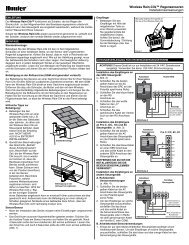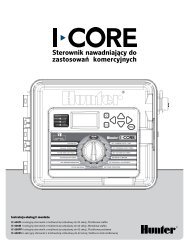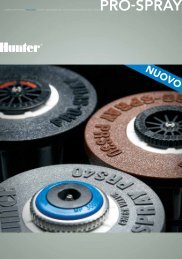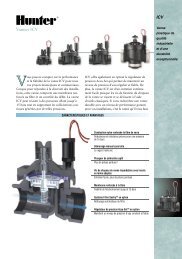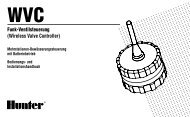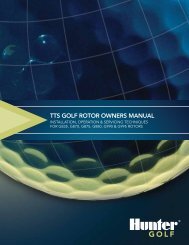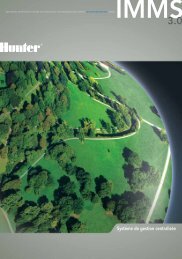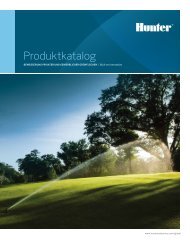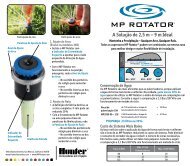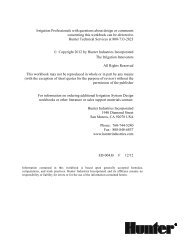The handbook of Technical irrigaTion informaTion - Hunter Industries
The handbook of Technical irrigaTion informaTion - Hunter Industries
The handbook of Technical irrigaTion informaTion - Hunter Industries
You also want an ePaper? Increase the reach of your titles
YUMPU automatically turns print PDFs into web optimized ePapers that Google loves.
Friction Loss ChartsReference Tables <strong>of</strong> Selected DataHead Losses Through Standard Foot Valves1½" 2" 2½" 3" 4" 6" 8" 10" 12"Head Loss in Feet1 39 66 96 152Flow in GPM268 632 1122 1805 26032 57 97 140 221 390 919 1632 2625 37863 71 120 175 275 486 1145 2032 3269 47134 83 141 204 322 568 1337 2374 3819 55075 94 159 230 363 641 1509 2678 4308 62136 104 175 254 401 707 1665 2956 4755 68367 113 190 276 435 769 1810 3212 5168 74528 121 205 297 468 826 1945 3453 5555 80109 129 218 317 499 880 2073 3680 5920 863610 137 231 335 528 932 2195 3896 6267 9037Table <strong>of</strong> Approximate Pressure Losses for Pipe FittingsListed in Equivalent Feet <strong>of</strong> PipeSteel Fitting Type ½" ¾" 1" 1¼" 1½" 2" 2½" 3" 4" 6" 8"Coupling 0.6 0.8 1.0 1.2 1.5 2.0 2.5 3.0 4.0 6.0 8.0Run <strong>of</strong> St. Tee 1.0 1.0 1.5 2.0 2.0 2.5 3.0 4.0 5.0 7.0 10.0Tee, Side Outlet 3.0 4.5 5.0 7.0 9.0 11.0 13.0 16.0 20.0 31.0 42.0Tee, Run Reduced ½" 1.5 2.5 3.0 4.0 5.0 6.0 7.0 8.0 12.0 16.0 20.0Elbow, 90° 1.5 2.5 3.0 4.0 5.0 6.0 7.0 8.0 12.0 16.0 20.0Elbow, 45° 0.75 1.0 1.3 1.7 2.0 2.5 3.0 3.5 5.0 7.5 10.0Corporation Stop 9.0 9.0 9.0 9.0 9.0 9.0Curb Stop 6.0 6.0 7.0 7.0 8.0 8.0Plastic IPS orCopper Fitting Type ½" ¾" 1" 1¼" 1½" 2" 2½" 3" 4" 6" 8"Coupling 1.5 2.5 3.0 3.0 4.0 6.0 7.0 8.0 11.0 18.0 24.0Run <strong>of</strong> St. Tee 2.5 3.0 4.0 5.0 6.0 8.0 9.0 11.0 15.0 21.0 28.0Tee, Side Outlet 7.0 9.0 12.0 15.0 18.0 24.0 30.0 36.0 45.0 70.0 90.0Tee, Run Reduced ½" 3.5 4.5 6.0 8.0 9.0 11.0 14.0 17.0 24.0 34.0 45.0Elbow, 90° 3.5 4.5 6.0 8.0 9.0 11.0 14.0 17.0 24.0 34.0 45.0Elbow, 34° 1.5 2.0 3.0 3.5 4.0 5.0 7.0 8.0 10.0 16.0 20.0To use this chart, multiply the approximate “equivalent feet <strong>of</strong> pipe” value by the proper pipe pressure loss per 100feet rating, then divide by 100. <strong>The</strong> result is the fitting loss in PSI.Note: It is recommended that the above chart be used only when the manufacturers recommended pressure lossvalues are not available.127



